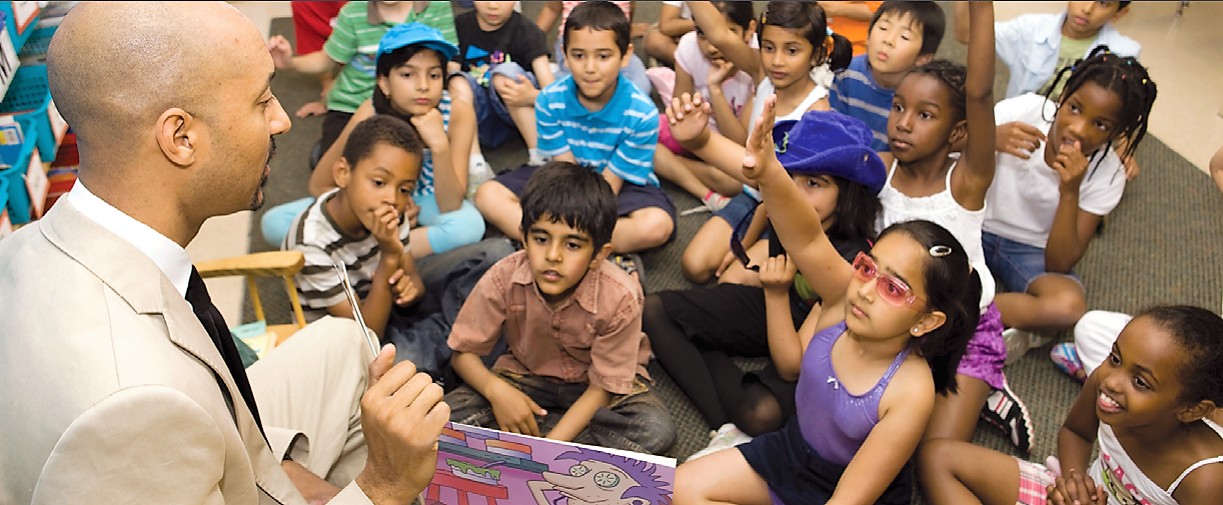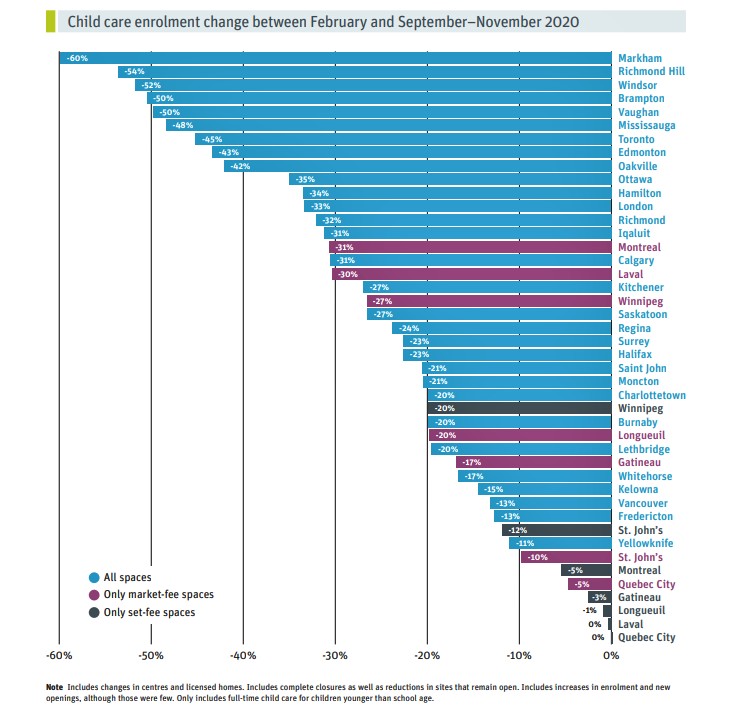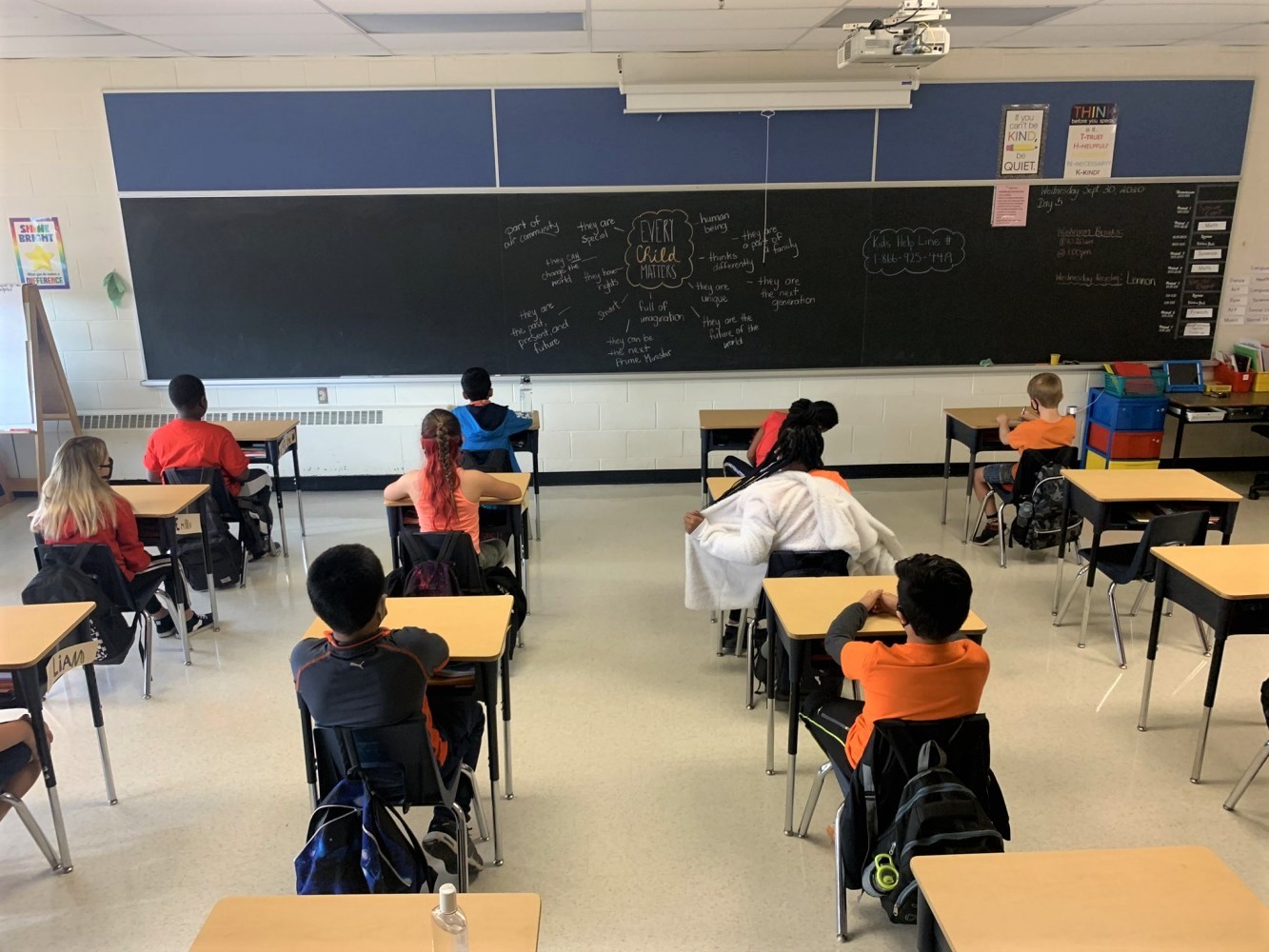
Child care enrolment in Peel drops off a cliff as fees rise again
In Brampton and Mississauga, the state of child care is becoming increasingly desperate for working families. Prices in the two cities are among the highest in Canada, while research has listed both among the most sparsely served areas for child care in the entire country.
A new report, entitled Sounding the Alarm and published by the Canadian Centre for Policy Alternatives, has laid out the impact of COVID-19 on Canada’s child care sector. In Peel Region, where the pandemic has hit a majority non-white community especially hard, the impact on child care has been devastating.
Conducted by phone, the survey approached child care centres across Canada between September and November 2020. The results? A dramatic decline in child care enrolment in every city outside Quebec, where the government heavily subsidizes the industry, with each reporting at least 10 percent fewer children in care in the fall of 2020 compared to February, before the pandemic began.
In Brampton and Mississauga, the enrolment drops have been enormous.
Between February and the fall, there were 50 percent fewer children enroled at child care centres in Brampton and 48 percent fewer in Mississauga. The data indicate a dramatic shift in how parents are trying to care for their children in a region where unemployment has risen and COVID-19 continues to wreak havoc with education.

In real terms, the report estimated 5,000 fewer children at daycares in Mississauga and 3,500 in Brampton.
In Ontario, child care is provided by the profit and nonprofit sectors, which rely on fees from parents to stay afloat. The sharp drop offs in enrolment threaten child care centres across Peel, where fees are already eye wateringly high.
A 2018 report, also by the Canadian Centre for Policy Alternatives, found Brampton had the second worst provision of child care in the country, with Mississauga also inside the top ten for worst childcare coverage. The report found the L6Z postcode in Brampton had the best coverage in the city at 42 percent and L6R was the worst with just 10 percent.
Overall, Brampton had a child care coverage rate of just over 21 percent, while Mississauga had a rate of 35 percent.
Inflexible zoning rules in Brampton are at least partly to blame for its lack of child care. Planning documents do not allow child care centres to be opened within residential zones, which cover most of the city. Instead, child care providers are listed under “institution type one”, a designation shared with religious institutions and private schools. Sometimes, child care facilities are also permitted within certain commercial, industrial or mixed zoning areas.
An interactive map by GeoHub on the City of Brampton’s website shows that land zoned specifically for these institutions is sparse and mostly taken up by schools or for religious uses. This strict zoning has made it difficult to integrate child care spaces as the City of Brampton has rapidly grown over the past four decades.
That growth has not been accompanied by zoning and other policies to accommodate hundreds of thousands of families that now live in the city.
Martha Friendly, executive director Childcare Resource and Research Unit and co-author of Sounding the Alarm, says the profit model of child care has also led to lower provisions in Peel.
“When they build a new community, they have to put in sewers and roads and all sorts, you don’t have to put in child care,” she told The Pointer. “[Government] waits until private individuals, who might be a parent group, or the YMCA or an entrepreneur, until somebody turns up to open it. It is probably the main reason that we have child care deserts.”
Planned changes under Bill 108’s Community Benefits Charge could improve this, with the option to include child care in the formula. But with the nonprofit and profit sector responsible for provisions, it is unclear how this money would be calculated, collected and doled out.
Defenders of the current model would say it’s basic market economics: there are children who need to be catered to, so entrepreneurs swoop in. The reality is, that’s not how it works.
Relying on an expensive and generally for profit model, child care providers are looking to make money. Areas in Brampton and Mississauga where residents have less disposable income are naturally less appealing for businesses because many locals are unable to afford the fees private providers need to charge to make the operation worthwhile, with considerable profit margins. With money increasingly tight as a result of COVID-19 for many, some of Brampton and Mississauga’s less wealthy communities find themselves on the outside looking in.

The Pandemic's impact on education in Peel is also causing strain for parents in need of child care.
“I think this is what the pandemic showed: child care does not work as a market commodity,” Friendly added. “It depends on the income level in the catchment area. If you have a more affluent community there are more people, even in a pandemic, who are able to pay higher fees.”
In Peel’s two cities, there is barely any space for higher fees. At $1,194 per month, the median preschool-aged fees in Mississauga are the fourth highest in Canada, with Brampton’s $1,153 ranking seventh. A monthly median for infant fees of $1,606 makes Mississauga rates the second highest in the country, with Brampton fourth at $1,549.
In the context of significant unemployment or underemployment in Peel Region, these fees are out of reach for an increasing number of families.
Unemployment rates in Peel Region spiked dramatically at the end of 2020. Data show 33.2 percent of all 15 to 24-year-olds were unemployed in the fourth quarter of last year, while the overall rate sat at 12.8 percent. The figure was more than double the 4.9 percent registered in the fourth quarter of 2019.
“Child care is mostly funded through parent fees, it's not [government] funded, so… when the parent fee revenue wasn’t there for centres anymore, it basically kind of ripped the band aid off,” Friendly said. “Think about these operators: whether they’re profit or not profit, they’re trying to cover their budget. They’re kind of stuck. The same number of parents aren’t coming, but putting up their fees puts them in a catch 22.”
Despite the difficult circumstances, fees in Peel Region rose again in 2020. It’s not clear how much higher they can go before the drop in enrolment spirals into terminal decline and the sector completely drying up in an area that’s already called a childcare desert.
The median preschool aged fees, for example, rose highest in Brampton overall. Whereas Winnipeg saw a three percent drop, fees spiked 21 percent in Brampton and 15 percent in Mississauga.
A separate survey question found that only seven percent of child care centres in Brampton and four percent in Mississauga raised their fees for COVID-19-related reasons. This suggests the majority of fee increases in both cities were business as usual.
“The substantial reduction in child care enrolment will have obvious knockon effects for child care service providers, who normally depend mostly on parent fees and still have fixed costs like rent, heat, and electricity, as well as staffing costs, even if spaces aren’t completely full,” the report explains. “Financial instability is the most predictable result of the drop in enrolment for child care centres and family child care providers.”
For Friendly, the problems exposed in Brampton, Mississauga and beyond are nothing new. Without a national child care strategy to provide support to families of all income brackets and backgrounds, prices seem likely to increase until the system breaks entirely.
“It was a non-system before and everybody was aware of it.”
Email: [email protected]
Twitter: @isaaccallan
Tel: 647 561-4879
COVID-19 is impacting all Canadians. At a time when vital public information is needed by everyone, The Pointer has taken down our paywall on all stories relating to the pandemic and those of public interest to ensure every resident of Brampton and Mississauga has access to the facts. For those who are able, we encourage you to consider a subscription. This will help us report on important public interest issues the community needs to know about now more than ever. You can register for a 30-day free trial HERE. Thereafter, The Pointer will charge $10 a month and you can cancel any time right on the website. Thank you.
Submit a correction about this story


